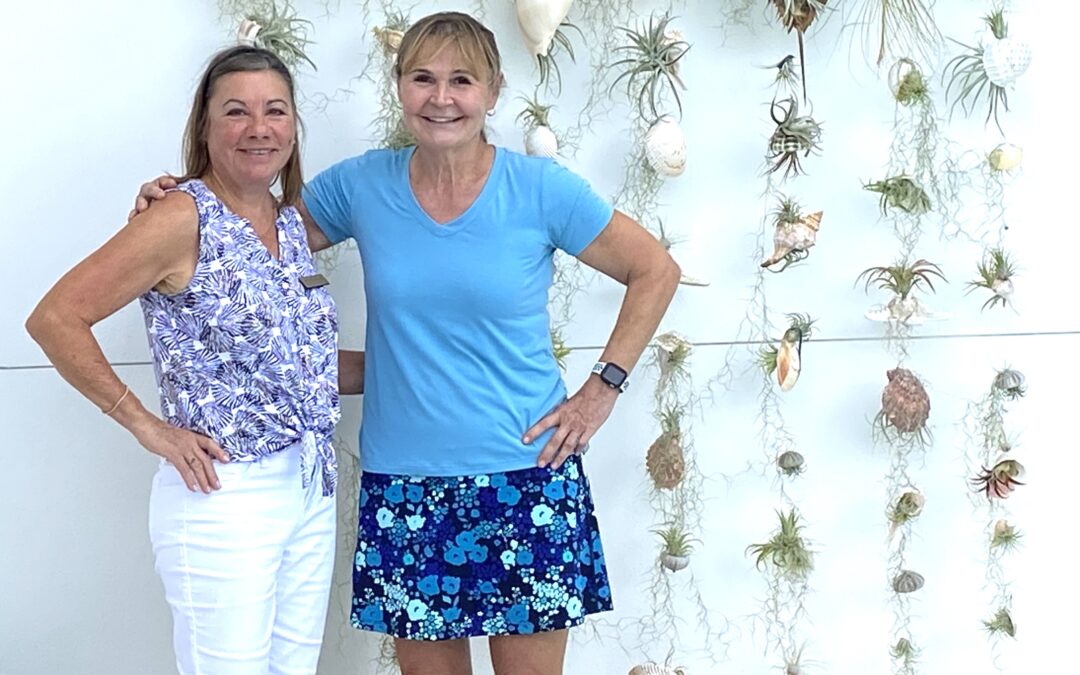Submitted By: Sara Wolf
Calusa Garden Club of Marco Island – Publicity Chairperson
Tillandsia, or “air plants,” are epiphytes of the bromeliad family that grow while holding onto trees, bark, or even stones, without an extensive root system. They come in over 650 different types, of varied colors, shapes and sizes.
For the July workshop of Calusa Garden Club of Marco Island, Club members Linda Schwoeppe and Eve Kubinsky prepared an educational presentation and workshop materials to educate Club members about tillandsia. The workshop, held at Kubinsky’s residence, featured displays of tillandsia owned by Schwoeppe and Kubinsky, some of which were shown in puts and “airplant condos” created by the two women in their own ceramic workshops. Both Schwoeppe and Kubinsky are accomplished potters in addition to being Garden Club members and gardeners.
About 20 garden club members enjoyed the educational presentation about tillandsia and peppered Schwoeppe and Kubinsky with questions. Tillandsia don’t absorb water and nutrients from their roots, but through their leaves, which may resemble spikes or flat ribbons. Schwoeppe described the varieties of tillandsia, such as small spidery light grayish-green clumping types, dark green puffs with leaves that look like ribbons and resemble other bromeliads, and long Spanish moss that hangs from trees in Marco Island and throughout the southern United States.
Schwoeppe and Kubinsky also covered the watering needs of these plants, stating that although we call them “air plants,” tillandsia need water to survive. They described how they soak their own tillandsia in buckets or basins of water about once a week. They soak them less often if temperatures outside are mild, and more often if temperatures outside are very hot or if they keep the plants inside where the air conditioning reduces the humidity level compared to Marco Island’s outside humidity level. Then Kubinsky showed the group the “wall of tillandsia” she and her husband John Johnson had created on their lanai. They hung fishing line between top and bottom metal rods to create a frame and then fastened shells containing tillandsia along the vertical axes. The result was a beautiful curtain of shells and plants.T
The workshop portion of the day followed the educational presentation. Six garden club members had pre-ordered a tillandsia display kit , and Schwoeppe showed them how to glue tillandsia onto cut portions of cork tree bark with E6000 glue. The members then added decorative shells to make a lovely decorative display. In addition, Schwoeppe gave the participants an offshoot from her pink quill tillandsia that they planted in small pots of orchid bark growing medium. The beautiful pink quill tillandsia sends up a flat pink oval flower spike that looks woven, like a basket. The members were thrilled with their creations and showed each other their versions of the project.
The photos show Susan Oldershaw, Jenn Ferrier, Laura Furlong, Barbara Messner, Linda Ariel and Sara Wolf with their tillandsia creations and pink quill tillandsia, and Shwoeppe and Kubinsky in front of Kubinsky’s wall of tillandsia.
Calusa Garden Club of Marco Island is a member of the Florida Federation of Garden Clubs. Membership is open to persons interested in horticulture, floral design and environmental matters residing 5 months or more in Collier County.
Calusa Garden Club of Marco Island meets the second Monday of each month, October through April. If you are interested in membership, please contact the Garden Club at calusagardenclub@aol.com. For updates and information, please visit the Garden Club’s website, calusa.org, or visit the Club’s Facebook page Calusa Garden Club.
# # #
The pictures were taken by Sara Wolf.
Photo Descriptions:
Linda Schwoeppe, left, and Eva Kubinsky, right in front of Eva Kubinsky’s wall of tillandsia on the Kubinsky-Johnson home lanai.
- Group photo of Calusa Garden Club members as they work on tillandsia displays. Clockwise from the front: Barbara Messner, Jennifer Ferrier, Sara Wolf, Laura Furlong, Sue Oldershaw and Linda Ariel.
- Sue Oldershaw shows her pink quill tillandsia and cork log tillandsia display.
- Linda Ariel shows her pink quill tillandsia and cork log tillandsia display.
- Close-up photo of tillandsia glued to a piece of cork tree bark.

